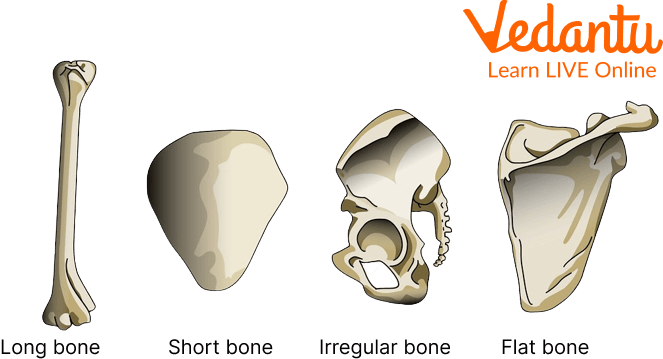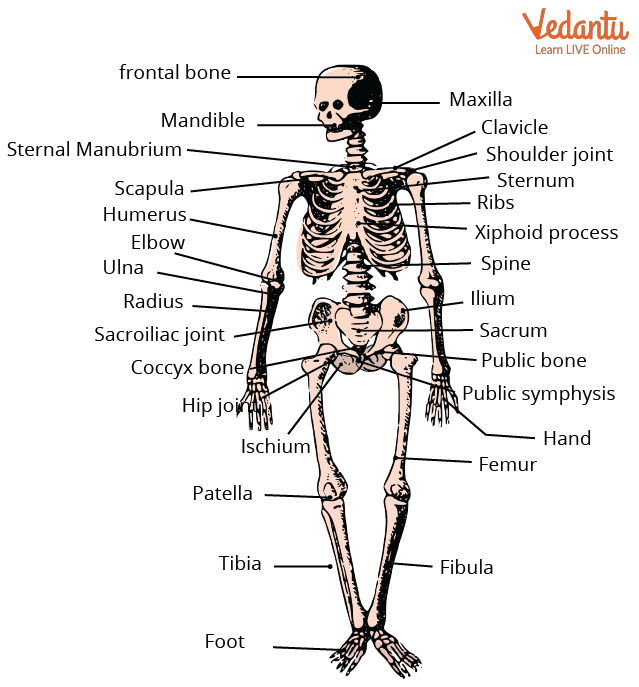




Introduction to Bones in Human Body
Hey, do you remember the “Grim Reaper” from the show “Grim Adventure of Billy and Mandy”? He was essentially not a human, rather a talking skeleton. The skeleton is the inner hard structure of our body and is made of a number of bones. Bones are solid structures made up of proteins and minerals and provide a shape to the body. They act as a protective layer for all the internal organs such as the brain, heart, lungs, etc and they are known to give support to the organs within the body and also anchor muscles.
Types of Bones in the Human Body
There are a variety of bones found in our body and can be of multiple sizes and shapes.
There are 4 major types of bones in our body, i.e. long, short, flat, and irregular.
Long Bones
These bones have a much greater length than width and hence are called long bones.
They can be described as a long shaft almost like a rod with two bulky ends looking like a dumbbell.
They are mostly very solid but might have a large number of spongy portions in them at both ends.
The bones of the thigh, leg, arm, and forearm are all long bones.
Short Bones
These bones are cube-shaped with almost equal length and breadth.
These bones are primarily spongy and covered with a thin layer of compact bone.
The bones present in the wrist and ankle are the short bones.
Flat Bones
These bones do not have much volume and are essentially flat and thin and also curved.
Cranium is made up of flat bones.
Irregular Bones
These are the bones that do not have a specific shape in order to classify them into any of the above groups.
These are the spongy bones that are covered by a thin layer of compact bone.
Bones of the vertebrae and some skull bones are all irregular bones.

Types of Bones
List of Human Bones
Humans have a total of 206 bones in their bodies.
There are many groups of bones in the human body.
Many parts of our skeleton are made up of multiple small bones joined together to form a proper structure.
The various groups include,

Bones
Bones in the Head:
Cranial Bones (8):
Frontal, parietal (2), Temporal (2), Occipital, Sphenoid, Ethmoid
Facial Bones (14):
Mandible, Maxilla (2), Palatine (2), Zygomatic (2), Nasal (2), Lacrimal (2), Vomer, Inferior Nasal conchae (2)
Ear Bones (6):
Malleus (2), Incus (2), Stapes (2)
Throat Bones (1):
Hyoid
Shoulder Bones(4):
Shoulder blade (2), Collarbone (2) (also called the clavicle)
Thorax Bones (25):
Sternum (1), Ribs (2 x 12)
Vertebral Column Bones (24):
Cervical vertebrae (7), Thoracic vertebrae (12), Lumbar vertebrae (5)
Upper Arm Bones (2):
Humerus (2)
Forearm Bones (4):
Radius (2), Ulna (2)
Wrist Bones(16):
Scaphoid (2), Lunate (2), Triquetral (2), Pisiform (2), Trapezium (2), Trapezoid (2), Capitate bone (2), Hamate (2)
Palm Bones:
Metacarpals (5 x 2)
Finger Bones:
Proximal phalanges (5 x 2), Intermediate phalanges (4 x 2), Distal phalanges (5 x 2)
Pelvis Bones (4):
Sacrum, Coccyx, Hip bone (2)
Leg Bones (8):
The femur or thigh bone (2), Patella (2), Tibia (2), Fibula (2)
Ankle Bones(24):
Calcaneus (heel bone) (2), Talus (2), Navicular (2), Medial cuneiform (2), Intermediate Cuneiform (2), Lateral cuneiform (2), Cuboid (2), Metatarsal bone (5 x 2)
Toe Bones:
Proximal phalanges (5 x 2), Intermediate phalanges (4 x 2), Distal phalanges (5 x 2)
Function of Bones
They provide structural support to the body.
The bones joined at different locations allow various movements.
They are known to protect various vital organs such as the rib cage protects the heart and lungs.
The blood in our body is formed within the bones by the bone marrow or specifically the red marrow.
The bones are also important for storage of minerals such as calcium and phosphorus.
Summary
Bones are the framework of the body which is important to stand erect and help to protect different delicate organs. The largest and strongest bone is the femur or thigh bone. The bones won’t grow after puberty, the density and strength change over time.
FAQs on Bones Names
1. What are the different bones in the human skeleton?
There are 206 bones in all in the human body.
The human body is made up of numerous different bone groupings.
Numerous small bones are linked together to generate larger bones in many places of our skeleton.
among the numerous groups are,
Facial bones
Ear bones
Throat bone
Shoulder bones
Thorax bones
Vertebral column
Upper arm bones
Forearm bones
Hand bones
Wrist bones
Palm bones
Finger bones
Pelvis bones
Leg bones
Feet bones
Toe bones
Cranial bones
2. Define the long bones?
These bones are referred to as long bones because their length exceeds their width by a wide margin. They can be described as having a long, nearly rod-like shaft and two hefty ends that resemble dumbbells. Although they may contain a significant amount of spongy areas at both ends, they are generally fairly solid. Long bones include those in the thigh, leg, arm, and forearm. These bones have a much greater length than width and hence are called long bones.
3. What is the function of bone?
Different movements are possible due to the bones' numerous points of joining. The red marrow in particular, found in the bone marrow, is responsible for producing the blood in our bodies. They give the body structural support. The rib cage is known to protect the heart and lungs, among other essential organs. Minerals like calcium and phosphorus are crucial to store in the bones.









